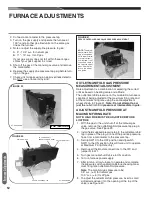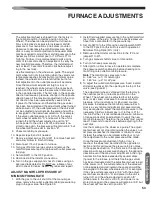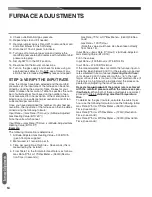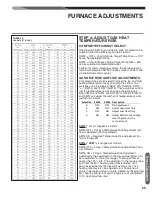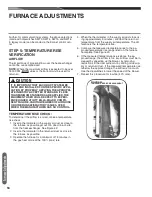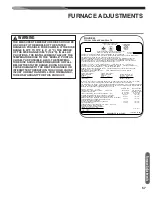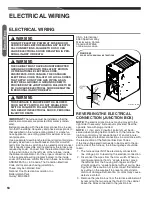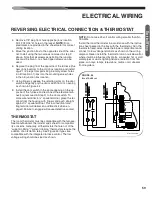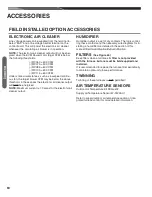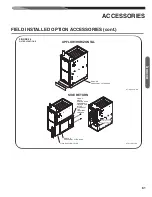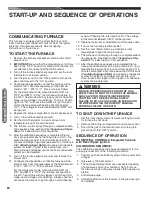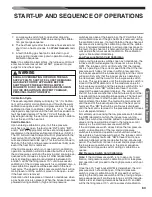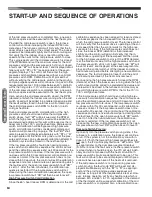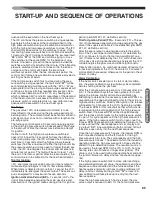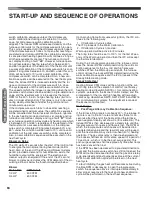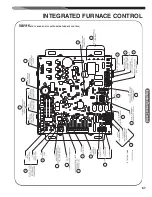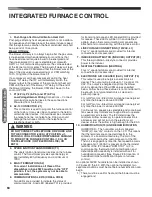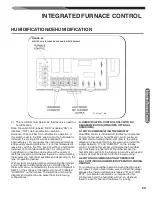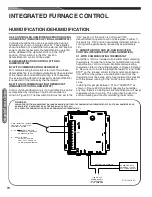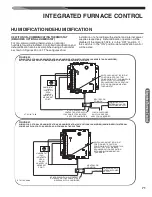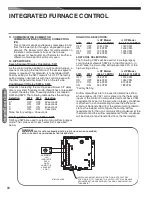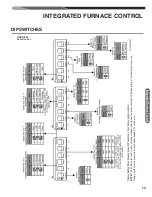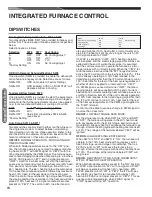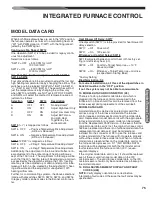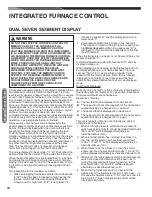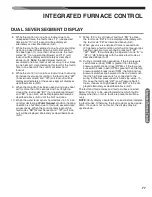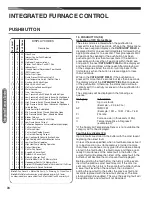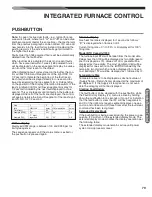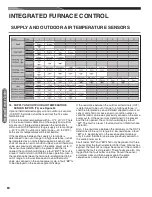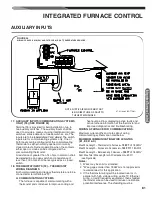
66
In
te
gr
at
ed
F
ur
na
ce
C
on
tro
l
switch calibration sequence unless the mid pressure
switch malfunctioned during cold calibration (in which
case, hot mid pressure switch calibration will be
skipped).The inducer RPM is decreased steadily and the
furnace control waits for the mid pressure switch to open.
This cycle is repeated until the mid pressure switch opens.
If the mid pressure switch does not open after reaching
a
pre-determined minimum
RPM, the calibration sequence
is cancelled and heating operation will continue as long as
all other requirements are met. The furnace control will
set, display and log a fault
“65”
. However, furnace opera-
tion will exclude any heating rate which is between 50%
and 65% regardless of the demand of the thermostat until
a successful calibration of the mid pressure switch is com-
pleted. Firing rates between 50% and 65% under this con-
dition will be fixed to 70% until a valid calibration of the
mid pressure switch can be completed. Also, a new cali-
bration sequence will be executed on the next heat cycle.
Next, the inducer RPM is increased steadily and the fur-
nace control waits for the mid pressure switch to close.
The cycle repeats until the mid pressure switch closes.
The speed at which the inducer is operating when the mid
pressure switch closes shall be added to a pre-determined
value and the resultant sum is to be used as the target
RPM for the 50% to 65% hot gas heating rates (two min-
utes or longer after ignition). This value is only to be used
during steady-state heat and after the ignition and two
minute warm-up period.
If the mid pressure switch fails to close after reaching a
pre-determined maximum value, the calibration sequence
will be cancelled and the furnace will continue to operate
in the gas heating mode and will also set, display and log
furnace control will set, display and log a fault
“67”
. How-
ever, furnace operation will exclude any heating rate which
is between 50% and 65% regardless of the demand of the
thermostat until a successful calibration of the mid pres-
sure switch is completed. Firing rates between 50% and
65% under this condition will be fixed to 70% until a valid
calibration of the mid pressure switch can be completed.
Also, a new calibration sequence will be executed on the
next heat cycle.
Blower on Delay
The IFC waits 22 seconds after the start of the ignition trial
to energize the main blower during heat mode (call for
heat). Also, at the end of the 22 second blower on-delay
period, provided a demand for humidification exists, the
humidifier output will be energized. The electronic air
cleaner output is energized at the end of the 22 second
blower on delay period unless the CFM demand of the cir-
culating airflow is below the threshold specified below:
Blower
Motor Size
CFM Cutoff
1/2 HP
500 CFM
3/4 HP
600 CFM
Upon proving flame from successful ignition, the IFC con-
tinues in the following way:
1. If Calibration Cycle is active:
The IFC proceeds to the Warm Calibration.
2. If Calibration Cycle is not active:
Warm-up period will be active for 2 minutes.
The firing rate should be set to 100 % for the first 22 sec-
onds of the Warm-up period and then the IFC will accept
the thermostat demand.
During the 2 minute warm-up period, the furnace control
uses the inducer RPM’s determined during the cold cali-
bration sequence for the low, mid and high pressure
switches. When the Warm-up period ends, the furnace
control will use the inducer RPM’s determined during the
warm calibration sequence and the IFC proceeds to the
Steady State Heating mode.
Steady State Heat
Heating blower CFM values will be a function of the cur-
rent firing rate and the selection of comfort or efficiency
heating modes (dipswitch SW-18 or, for communicating
systems, selected in the Econet Control Center) and the
arrangement of the low and high heating airflow adjust-
ments using dipswitches SW13, SW14, SW15 and SW16
(for communicating systems, the adjustment is made at
the Econet control center).
Post-Purge:
a.
Post-Purge After any Calibration Sequence:
If the furnace firing rate is not already 40%, the furnace fir-
ing rate is set to the 40% rate and remains there for 45
seconds after the end of the heat call and the furnace
seven-segment display will show CL (for calibration). The
inducer RPM is then decreased at a steady rate until the
low pressure switch opens and flame is lost. The RPM at
which the low pressure switch opens will be added to a
pre-determined value and the resultant sum will be used
until the next calibration cycle for low-heat (40%) heating
operation. The gas valve relay is then de-energized and
the inducer shall remain at this same speed for a period of
10 seconds - which is to be the post-purge period. This
post-purge sequence shall take place any time after flame
has been sensed then lost.
If the RPM has been decreased to a pre-determined mini-
mum and the low pressure switch has still not opened, the
RPM will not be decreased further and the gas valve relay
is de-energized and post purge takes place at the current
RPM. A new calibration cycle will be forced on the next
heat cycle.
If a fault inhibiting the gas heat call becomes active during
the time RPM is decreasing to open the low pressure
switch, the sequence above is interrupted immediately to
allow proper response to the fault and a new calibration
cycle will be performed on the next heat sequence.
START-UP AND SEQUENCE OF OPERATIONS
HUMIDIFICATION/DEHUMIDIFICATION

